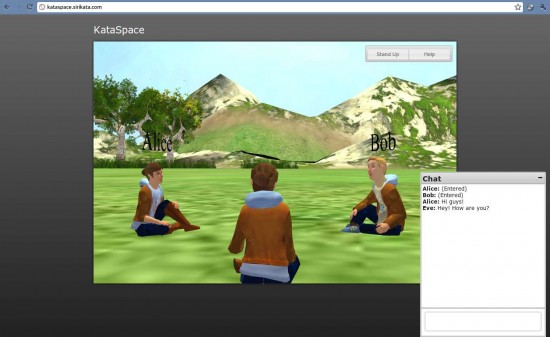California-based Katalabs has just released a free iPad and iPhone-friendly Web-based virtual world viewer, KataSpace, which works in conjunction with the open source Sirikata virtual world server software.
KataSpace is built on the WebGL and HTML 5 Web standards, which means it will run in browsers without a plugin, and will also run on the iPhone and iPad. Eventually.
The standards aren’t yet implemented in any standard browsers. To access the world, beta testers need to use the experimental Firefox 4 Beta 7 browser.]
“When Apple will update the next version of Safari to include this is anybody’s guess,” Katalabs CEO Henrik Bennetsen told Hypergrid Business. However, Apple is dedicated to supporting HTML 5, he added, so the KataSpace viewer might be accessible on the iPad soon.
Sirikata is an alternative to OpenSim, Open Wonderland and Open Cobalt in that it is free software that can be used to create a virtual world. It is the first to come out with a HTML 5-based viewer. However, it lags behind the other platforms, especially OpenSim, in many key respects.
“It’s just a very simple permutation right now,” said Bennetsen. “All you can currently do in there is walk around, sit down, and chat with people. That’s all you can do.”

“We know that what’s currently there in KataSpace isn’t fully featured like something that’s been around a little longer — like anything else, pretty much,” he said. “The only reason we’re getting some attention is the promise of 3D in the browser with no plugins, no installs. The promise is that when you run native technology like that, you can get onto the iPad in the future. You’re seeing an application that has avery low feature set, but the technologies it’s built on are a bit more promising than others out there.”
There are currently no HTML 5 viewers for OpenSim, though there is no technical reason why such viewers couldn’t be developed. In addition, there are two competing Unity-based viewers for OpenSim currently under development. Unity is a browser-based platform, a 3D alternative to Flash, and is already compatible with the iPhone and iPad. It requires a downloadable plugin, but users who have previously played other Unity-based browser games will already have it installed.
Feature details
Sirikata is a mesh-based platform, and 3D objects in the Collada standard can be imported in. However, there is no marketplace specifically for Sirikata objects — individuals and companies who need objects need to find or create the mesh objects, import them, and create all needed scripts from scratch.
Sirikita allows in-world scripting in the Javascript language. The software itself is written in C++. The KataSpace viewer is written in HTML, CSS and Javascript.
By comparison, Open Wonderland is written in Java and allows Java in-world scripting. OpenSim is written in C# and allows in-world scripting using the Linden Scriping Language (LSL) as well as the OpenSim Scripting Language (OSSL), C#, Visual Basic and Javascript.
Like OpenSim, Sirikata can be run across multiple servers to build a single, large social grid. It can also be used on a single server to create a small virtual space, as well. Regions can be any size or shape, Bennetsen said.
Unlike OpenSim or Second Life, however, Sirikata isn’t for the amateur. There are no in-world editing tools — all the environments have to be created outside the platform. Assembling the world requires professional developers.

“If you are a Web designer who can install software on a Web server, that’s the level of skill that it takes right now,” said Bennetsen.
There are no inventories, so avatars can’t change clothes or give objects to one another — or pull objects out of their inventory to place on the ground. There is no built-in weather and no sun or moon.
There are also no groups, no in-world voice, no currency — none of the features that virtual world users have come to expect from their platforms. However, Sirikata is extensible, so it’s possible that third-party developers, or virtual world owners, will build these services or connect to existing Web-based services.
“We want this to be a technology that integrates more with the Web,” said Bennetsen. “If you want group functionality, you can set up a Facebook group and integrate with that. ”
The same goes for voice, he said.
“There are several in-browser voice solutions, and some interesting things coming down the pike with HTML5 and we’re thinking of leveraging that,” he said. “If there is something that already works in the browser for this, there’s no reason to roll your own.”
There is also no current way to export an entire world, the way that you can export an OpenSim region with a “save OAR” command.
“You have to dig into the scripts to do that,” said Bennetsen.
Similarly, there is currently no way to upload a pre-made world or to export or import a complete object — mesh, textures, and scripts – in Sirikata format. The lack of these export and import functions will make it difficult, at the beginning, to create an ecosystem of content, content providers, and user communities as has happened with Second Life and OpenSim.
No ecosystem
Unlike OpenSim, which has dozens of companies offering turn-key setup and hosting of the worlds, as well as content and service providers, today only Katalabs provides Sirikata-related services, and it does not offer hosting. The company says that it is currently developing an online environment for young people with cancer, a couple of museums, and a group in Demark looking for a virtual space where they can meet, collaborate, and brainstorm business opportunities.
Users wishing to run a Sirikata world need to download all the files and install them on their Web servers themselves. However, both the back-end Sirikata server and the client-facing KataSpaces viewer are free and open source.
Bennetsen said that he expects to see third-party providers spring up to offer hosting and design services, or to create in-world building or editing tools for the platform.
“I could envision that a commercial entity would build something on top of that, that you click and deploy,” he said. For example, Sirikata can easily run on the Amazon cloud, so hosting companies would be able to offer instant, on-demand virtual spaces without having to invest in their own servers.
There is currently only one public world accessible with the KataSpace viewer — Katalab’s own test world, which is 250 meters by 250 meters, or just a little bit smaller than a single Second Life or OpenSim region.
Once other public worlds are created, to move from world to world, users just have to click on a URL. However, their avatars will not travel with them — there is currently no equivalent of the hypergrid for Sirikata.
“Maybe in the future, you’ll have an avatar that you show up with whereeveryou go, but that’s not something we’ve implemented yet,” said Bennetsen.
Licensing
Both Sirikata and KataSpace are released under the BSD open source license. That means that companies can create derivative works and keep them proprietary and charge for them if they wish.
Today, the OpenSim server software is also released under the BSD license. Third-party OpenSim viewers are released under the GPL license, which means that derivative works also have to be open source. Open Wonderland is also GPL, but is modular, so companies can release proprietary add-on modules.
Resources
Kataspace download files are available here.
More technical details about Kataspace available here.
Sirikata download files are available here.
- OSgrid back online after extended maintenance - April 16, 2025
- Analysts predict drop in headset sales this year - March 25, 2025
- OSgrid enters immediate long-term maintenance - March 5, 2025
